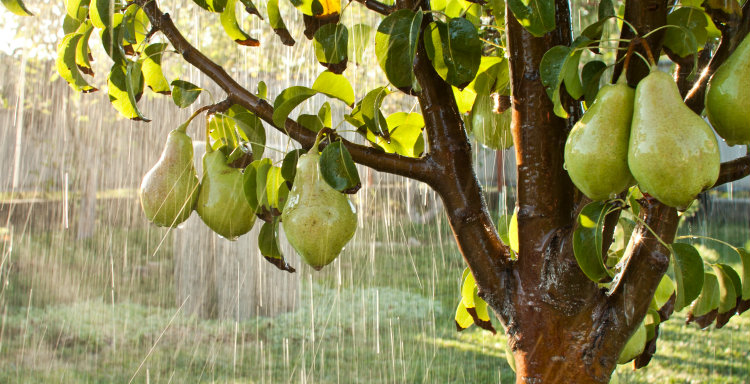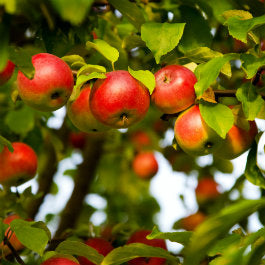
Who doesn’t enjoy the taste of a freshly picked apple or juicy plum taken straight from the branch? The addition of an ornamental fruit tree in your garden not only promises a delicious harvest but a riot of colour when the trees are laden with beautiful blossom in spring.
Our wonderful Aussie climate is well equipped for growing these sunshine-loving trees, and they don’t require as much space as you might think, particularly as they grow upwards rather than spreading out, making fruit trees an ideal addition to small gardens whilst working beautifully to divide a large outdoor space too. Extending beyond the veggie patch, fruit trees provide a good source of shade and privacy and create a focal point in the garden in addition to providing sweet fruits to eat.
As they are best planted in winter, we’ve concentrated on growing deciduous fruit trees for part one of our ‘How to Grow’ series, which includes the likes of nectarine, fig, apricot, peach, plum, apple and pear trees that fruit in summer and lie dormant in winter. Some fruit trees, such as peach, apricot and nectarine, are self-fertile, so they fruit even if planted alone. However, fruit trees such as apple, pear, plum and cherry require a cross-pollinator to bear fruit, so more than one tree needs to be planted.
Getting started…

Growing fruit trees can seem daunting, as they do require some pruning and care, however it is likely to be far less than you expect. In fact, you can grow fruit trees with minimal effort and pruning, but, if you want to be rewarded with a more bountiful crop, then some regular maintenance will be in order. Remember, patience in the beginning will pay off in years to come when you’ll be reaping the tree’s fruitful rewards.
Before you make any purchases it’s important to prepare your yard for the new arrivals. Fruit trees need to be planted in a sunny spot that receives at least six hours of sunlight per day year-round, with enough room to grow in – space them away from other plants and surfaces, and well-drained soil. Dig a hole larger than you need to help the roots spread out when planting. It’s also beneficial to add some organic material, such as compost, to the soil beforehand.
If you’re planting more than one fruit tree, plan where each one will be positioned, keeping in mind how much room they need to grow without overcrowding an area. When choosing a fruit tree, ensure you find out if it needs a pollinator. If you’re going to plant a fruit tree that does need cross-pollination for fruiting, then choose another variety that is in bloom at the same time and position it close by.
Growing for your climate

There are five common climatic zones in Australia: cool, temperate, sub-tropical, tropical and arid, and choosing the best fruit trees for the climate where you are will give you the greatest chance of success. Consider whether your garden is prone to frost, how cold it gets – or how hot and humid, and how wet the climate is. The likes of apple and peach trees grow well in cool and temperate climates, whilst citrus and more exotic fruit trees will thrive in arid, tropical and sub-tropical climates. Many fruit trees will come with guidance on chill hours, which will help you select the best varieties for the climate where you live. Low-chill trees are well suited to warm climates, whilst high-chill trees are ideal for the colder regions of Australia.
.jpg) Planting
Planting
Bare-rooted fruit trees can be purchased in winter when they are dormant, making them cheaper to buy and faster to establish than a potted tree. Create a small mound of soil in your ready-dug hole and lower the root ball of your tree on top of it. Spread out the roots and ensure the graft line at the base of the trunk is higher than the level of the ground, and that no roots are exposed. Start filling in the hole, firming soil carefully over the roots. Once planted your fruit trees will need to be staked to support them as they grow. Hammer a stake into the soil on either side of the tree, being careful to avoid the roots and allowing around 30cm gap from the trunk. Loosely tie the tree in place and water well.
Caring for your fruit trees

Pruning, careful watering, pest control and fertilising are the four main elements of caring for your new fruit trees. Whilst a young tree is establishing it will need water two or three times per week, depending on how the soil feels and the variety you’re growing. Hoselink’s Root Waterer & Soil Breaker is a great tool for delivering water directly to the roots underground to ensure the tree receives all the moisture it needs. It will require less watering as time goes on and hardly a drop when dormant, so do your research and get to know what your trees need and when.
A yearly application of fertiliser is best given at the end of winter or in early spring, and the type of fertiliser will depend on the variety of fruit tree you are growing, so be sure to check with your local nursery for advice.
Pests such as fruit fly can be a problem when growing fruit trees, resulting in spoiled fruit. Fruit fly traps and organic pest control solutions can be effective, as can removing any rotting fruit that may  attract them.
attract them.
Annual pruning is best left until well after you’ve harvested the crop in summer. Pruning in winter, when the tree has dropped its leaves, makes things a little easier. Start by clearing any dead, damaged or diseased wood and any old fruit. If there are any suckers sprouting from the trunk, remove them, as well as any watersprouts growing from the main branches. Prune small branches right back to the larger branch they are growing from and thin out any competing branches and branches growing downwards or crossing over one another. Know when to stop – once you have evenly spaced, healthy-looking branches with plenty of room for light and air to reach the canopy, you can take a step back. Keep checking your progress as you go until an open framework is achieved. Finally, prune back the outermost growth of the tree, cutting part way into each branch, close to the bud. Use sharp tools such as loppers, pruners, secateurs or a pruning saw for effective pruning – view Hoselink’s range of brilliant cutting tools here.
Harvesting fruit

To know when the fruit is ready for picking can be tricky, as how quickly the fruit ripens can depend on the climate and weather, but testing one or two for taste and texture will help you decide. If good fruit begins to fall off naturally then it is likely ready for harvest. Most fruit will taste sweet and feel firm when picked, with the exception of plums, apricots, peaches and nectarines that will feel soft. Most fruit will gently twist off the branch with the stalk intact, whilst cherries should be cut to keep the stalk and flesh together – our Handy Snippers are perfect for this.











